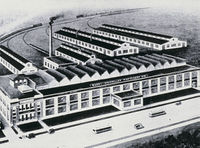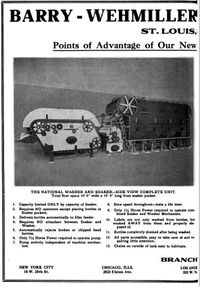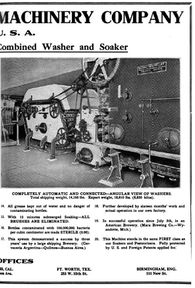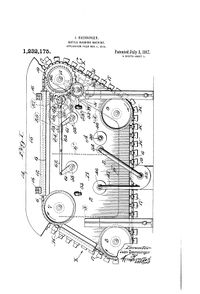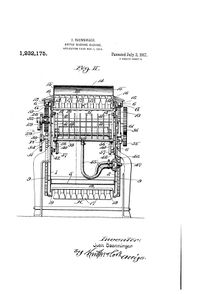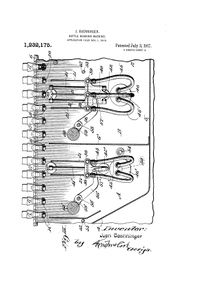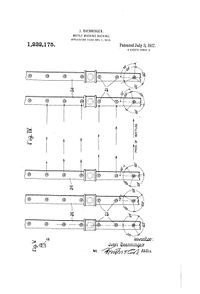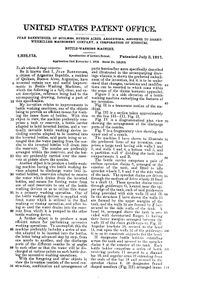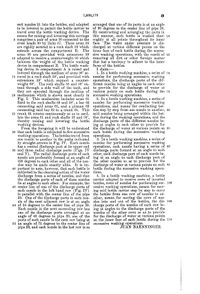Informationen zu Barry Wehmiller: Unterschied zwischen den Versionen
Rb (Diskussion | Beiträge) |
Rb (Diskussion | Beiträge) |
||
| (13 dazwischenliegende Versionen desselben Benutzers werden nicht angezeigt) | |||
| Zeile 1: | Zeile 1: | ||
| + | '''Barry-Wehmiller History'''<br> | ||
| + | Quelle: https://www.barrywehmiller.com/story/history 2021<br> | ||
| + | '''1885'''<br> | ||
| + | Thomas J. Barry becomes half owner of a small millwright and general repair shop in the south part of St. Louis, Missouri (USA).<br> | ||
| + | '''1888'''<br> | ||
| + | Barry opens a machine shop at 21st and Walnut streets, in St. Louis, Missouri (USA), to provide conveying and transportation equipment to malt houses. At this time, St. Louis was third in the nation for beer production—Anheuser-Busch alone sold 500,000-plus barrels of beer.<br> | ||
| + | '''1894'''<br> | ||
| + | Alfred Wehmiller, Barry’s brother-in-law, joins the millwright business as a draftsman. <br> | ||
| + | '''1897'''<br> | ||
| + | The Barry-Wehmiller Machinery Company is incorporated; with Barry as president and Wehmiller as secretary.<br> | ||
| + | '''1901'''<br> | ||
| + | The company designs and erects its first continuous basket pasteurizer, an economical machine that totally submerged refillable bottles. A soaking machine also is developed to fill and empty bottles of various solutions.<br> | ||
| + | From a Catalog: "Our soaking machines were the first ever built in which the tank was divided up into compartments or sections by transverse partitions, and in which the general direction of travel of the bottles was vertical instead of horizontal."<br> | ||
| + | '''1903'''<br> | ||
| + | Barry dies, and Wehmiller becomes president and treasurer.<br> | ||
| + | '''1913'''<br> | ||
| + | Barry-Wehmiller builds a new plant at 4660 West Florissant Avenue in St. Louis, Missouri (USA), with strategic access to railroads, moving from 21st and Walnut streets, which had housed the company since 1888. | ||
| + | From a Pamphlet: “The location affords unsurpassed railroad connections for the plant, which is supplied with three separate private switches for the transportation of all raw and finished products to and from the different buildings."<br> | ||
| + | {| class="galleryTable noFloat" | ||
| + | | [[File:1913_BW.jpg|200px|thumb|left|4660 West Florissant Ave., St. Louis, USA]]<br> | ||
| + | |} | ||
| + | '''1916'''<br> | ||
| + | Wehmiller is recognized for his contributions to the dairy industry.<br> | ||
| + | From a Press Notice: “Head of the Barry-Wehmiller concern, is one of the few St. Louisans who deserves the gratitude and praise of countless thousands of people throughout this country, for he is the inventor of the famous ‘Barry-Wehmiller Way’—equipment which is justly claimed and proved to be the ‘Last Word’ in the production of ‘Safe Milk’…. The Barry-Wehmiller wonderful equipment washes and sterilizes the bottles, fills them with clarified milk, seals them air-tight, submerging them for one hour and twenty minutes, pasteurizing the milk at 145 degrees and cooling it to 36 degrees.”<br> | ||
| + | '''1917'''<br> | ||
| + | Patent application granted to Wehmiller and Barry-Wehmiller for a “method of pasteurizing liquids.”<br> | ||
| + | '''1920'''<br> | ||
| + | Prohibition begins, and facing an 80 percent loss in US sales, Barry-Wehmiller focused on the international brewing industry and the production of dairy washers and pasteurizers, introducing the patented National pasteurizer during this time.<br> | ||
| + | '''1927'''<br> | ||
| + | Wehmiller dies, and his widow, Lillie, becomes president.<br> | ||
| + | '''1933'''<br> | ||
| + | Prohibition ends, reinvigorating the bottling machinery business and the brewing industry. In anticipation of the repeal of Prohibition, the Super-National bottle cleaner is developed.<br> | ||
| + | '''1934'''<br> | ||
| + | Alfred Wehmiller’s son Fred joins the company as a vice president after graduating from college the year before.<br> | ||
| + | '''1935'''<br> | ||
| + | Alfred is named general plant superintendent.<br> | ||
| + | Patent application granted to Barry-Wehmiller for an “apparatus for pasteurizing liquids in containers.”<br> | ||
| + | '''1939'''<br> | ||
| + | The revolutionary BW Vortex pasteurizer is introduced, expanding Barry-Wehmiller’s reach both within and outside of the brewing industry.<br> | ||
| + | '''1942'''<br> | ||
| + | Alfred Wehmiller’s son Paul is named a vice president, and devotes his time to US and international sales, especially in South America.<br> | ||
| + | Patent application granted to Barry-Wehmiller for a “process of pasteurizing liquids in containers.<br> | ||
| + | '''1944'''<br> | ||
| + | Barry-Wehmiller earns the Army-Navy “E” Award for its support of World War II production needs. The company converted its facilities to produce 20mm projectiles, shell washers, components and fixtures for bomber turrets, gun yokes and other machine tools; team members grow victory gardens on the grounds.<br> | ||
| + | From a US Navy website: “Representing only 5 percent of the estimated war plants in the nation, those plants meeting the stringent eligibility requirements ranged in size from a one-man plant to large corporations and included facilities that converted from peace to war production, as well as new plants built especially for war purposes…. Excellence in quality and quantity of production were two of the determining factors in granting Awards.”<br> | ||
| + | '''1946'''<br> | ||
| + | Barry-Wehmiller’s research department is founded to improve bottling machinery. <br> | ||
| + | '''1950'''<br> | ||
| + | A departure from the Super-National and its cleaning brushes, the International all-hydro bottle cleaner is introduced, with an impressive recommended operating speed of 500 bottles/minute. <br> | ||
| + | '''1951'''<br> | ||
| + | Lillie Rassieur (formerly Wehmiller) resigns as president. Fred becomes president, and Paul is named executive vice president. | ||
| + | Barry-Wehmiller Ltd. is founded in London to provide more effective service and modern machinery outside of the US, without currency restrictions.<br> | ||
| + | Barry-Wehmiller purchases the Edward Ermold Co. of New York, with its labelers and unpackers, as well as the Bruceway can markers and uncasers.<br> | ||
| + | '''1953'''<br> | ||
| + | William A. Chapman joins Barry-Wehmiller as executive assistant to Fred. Bill had been involved with the company as an Arthur Andersen accountant.<br> | ||
| + | ''1955''<br> | ||
| + | Barry-Wehmiller acquires the rights to manufacture the Hydro-Jet bottle cleaner for non-labeled bottles (soft drinks, primarily) and the New-Matic uncaser from the Liquid Carbonic Corporation.<br> | ||
| + | The annual BW Seminar begins to educate bottlers in both English and Spanish.<br> | ||
| + | '''1957'''<br> | ||
| + | Fred dies, and Bill Chapman becomes president. He had previously served as vice president, general manager and treasurer. With the growth of canned beer, nonreturnable glass and German competition, the company struggles to stay in business.<br> | ||
| + | '''1958'''<br> | ||
| + | Barry-Wehmiller de México S. A. de C. V. is formed in Mexico City to provide reliable technical advice, and to supply quality repair and maintenance parts more quickly and affordably.<br> | ||
| + | To improve service in Australia and nearby countries, Barry-Wehmiller (Australasia) Pty. Ltd. is formed.<br> | ||
| + | The Palleter is introduced, which automatically loads filled beverage cases onto pallets and unloads empty bottle cases from pallets in one simultaneous synchronized operation, bringing complete automation to bottling plants. The Causti-Clean removes labels from the soaking compartments of bottle washers.<br> | ||
| + | '''1959'''<br> | ||
| + | The Jagenberg Ultra-Tempo labeler is introduced, which impressively operates at 300 bottles/minute for paper labels and 250 bottles/minute for foil.<br> | ||
| + | Barry-Wehmiller team members traveled 280,000 miles around the world, visiting customers located everywhere from Helsinki to Singapore and Johannesburg to Toronto.<br> | ||
| + | '''1960'''<br> | ||
| + | Barry-Wehmiller celebrates its 75th anniversary. From an internal quarterly review published to honor the milestone: “Old timers at Barry-Wehmiller are a dime a dozen. Twenty and thirty year service records are common. Father and son or father and daughter combinations are on the payroll. Many a St. Louis parent has said, ‘Try to get a job there. Wait if you have to. It’s always been a good place to work.’”<br> | ||
| + | '''1960'''<br> | ||
| + | Barry-Wehmiller holds 34 US patents and 84 patents in 14 other countries.<br> | ||
| + | Said Bill Chapman: “The acceptance of our products through the years could not have resulted alone from the standards of quality they set, but is also due to the loyalty and support of our employees.”<br> | ||
| + | '''1963'''<br> | ||
| + | Ownership passes to the Chapman family.<br | ||
| + | '''1975'''<br> | ||
| + | Bob Chapman becomes chairman and CEO after father’s sudden death from a heart attack.<br> | ||
| + | Said Bob Chapman: “Within days of my dad’s death, our banker visited and told me they were freezing our line of credit. I remember thinking ‘I am not going down!’ In my mind, I had no other choice than to take direct control, cutting costs and implementing disciplines that ultimately moved the company into record profitability and financial stability within nine months.”<br> | ||
| + | '''1979'''<br> | ||
| + | Barry-Wehmiller establishes an operation in Clearwater, Florida (USA), specializing in the design and manufacture of Italian fillers for the Western beverage industry. <br> | ||
| + | '''Early 1980s'''<br> | ||
| + | Sluggish markets, global recession and other economic conditions trigger period of financial decline. Bank pulls the loan a second time. The leadership team challenges itself to reposition the company by redefining the core business and financial strategies.<br> | ||
| + | '''1986'''<br> | ||
| + | Barry-Wehmiller Design Group, an engineering consulting firm, headquartered in St. Louis, Missouri (USA), is formed.<br> | ||
| + | '''1987'''<br> | ||
| + | Barry-Wehmiller spins off two-thirds of the company in a $35 million IPO offering on the London Stock Exchange, divesting control of its European-based company, while retaining ownership of its historic brewery equipment business. This dramatically enhanced Barry-Wehmiller’s financial strength and marked the beginning of the modern chapter in the company’s history. Harvard Business School subsequently wrote a case study on this event in the company’s history.<br> | ||
| + | Barry-Wehmiller acquires ABC Conveyor & Auto-Flush Systems, Ltd., the company’s first acquisition after developing its modern growth strategy.<br> | ||
| + | '''1989'''<br> | ||
| + | Barry-Wehmiller acquires Pneumatic Scale Corporation in Quincy, Massachusetts (USA). It becomes Pneumatic Scale Angelus after the acquisition of Angelus Sanitary Can Company in 2007.<br> | ||
| + | Weitere Meilensteine s. www.barrywehmiller.com | ||
| + | '''1915 Annonce Western Brewer No. 45''' | ||
{| class="galleryTable noFloat" | {| class="galleryTable noFloat" | ||
| − | | [[File:1915_Annonce_BW_BJ_1.jpg|200px|thumb|left| | + | | [[File:1915_Annonce_BW_BJ_1.jpg|200px|thumb|left|Western Brewer 45/1915.<br> |
Quelle:http:\\books.google.com]] | Quelle:http:\\books.google.com]] | ||
| [[File:1915_Annonce_BW_BJ_2.jpg|195px|thumb|left|Western Brewer 45/1915.<br> | | [[File:1915_Annonce_BW_BJ_2.jpg|195px|thumb|left|Western Brewer 45/1915.<br> | ||
Quelle:http:\\books.google.com]] | Quelle:http:\\books.google.com]] | ||
| + | |} | ||
| + | '''1917 US Patent 1 232 175''' | ||
| + | {| class="galleryTable noFloat" | ||
| + | | [[File:1917_US1232175-1.jpg|200px|thumb|left|Patentschrift Seite 1]] | ||
| + | | [[File:1917_US1232175-2.jpg|200px|thumb|left|Patentschrift Seite 2]] | ||
| + | | [[File:1917_US1232175-3.jpg|200px|thumb|left|Patentschrift Seite 3]] | ||
| + | | [[File:1917_US1232175-4.jpg|200px|thumb|left|Patentschrift Seite 4]] | ||
| + | |} | ||
| + | {| class="galleryTable noFloat" | ||
| + | | [[File:1917_US1232175-5.jpg|200px|thumb|left|Patentschrift Seite 5]] | ||
| + | | [[File:1917_US1232175-6.jpg|200px|thumb|left|Patentschrift Seite 6]] | ||
| + | | [[File:1917_US1232175-7.jpg|200px|thumb|left|Patentschrift Seite 7]] | ||
|} | |} | ||
Aktuelle Version vom 22. November 2022, 20:02 Uhr
Barry-Wehmiller History
Quelle: https://www.barrywehmiller.com/story/history 2021
1885
Thomas J. Barry becomes half owner of a small millwright and general repair shop in the south part of St. Louis, Missouri (USA).
1888
Barry opens a machine shop at 21st and Walnut streets, in St. Louis, Missouri (USA), to provide conveying and transportation equipment to malt houses. At this time, St. Louis was third in the nation for beer production—Anheuser-Busch alone sold 500,000-plus barrels of beer.
1894
Alfred Wehmiller, Barry’s brother-in-law, joins the millwright business as a draftsman.
1897
The Barry-Wehmiller Machinery Company is incorporated; with Barry as president and Wehmiller as secretary.
1901
The company designs and erects its first continuous basket pasteurizer, an economical machine that totally submerged refillable bottles. A soaking machine also is developed to fill and empty bottles of various solutions.
From a Catalog: "Our soaking machines were the first ever built in which the tank was divided up into compartments or sections by transverse partitions, and in which the general direction of travel of the bottles was vertical instead of horizontal."
1903
Barry dies, and Wehmiller becomes president and treasurer.
1913
Barry-Wehmiller builds a new plant at 4660 West Florissant Avenue in St. Louis, Missouri (USA), with strategic access to railroads, moving from 21st and Walnut streets, which had housed the company since 1888.
From a Pamphlet: “The location affords unsurpassed railroad connections for the plant, which is supplied with three separate private switches for the transportation of all raw and finished products to and from the different buildings."
| |
1916
Wehmiller is recognized for his contributions to the dairy industry.
From a Press Notice: “Head of the Barry-Wehmiller concern, is one of the few St. Louisans who deserves the gratitude and praise of countless thousands of people throughout this country, for he is the inventor of the famous ‘Barry-Wehmiller Way’—equipment which is justly claimed and proved to be the ‘Last Word’ in the production of ‘Safe Milk’…. The Barry-Wehmiller wonderful equipment washes and sterilizes the bottles, fills them with clarified milk, seals them air-tight, submerging them for one hour and twenty minutes, pasteurizing the milk at 145 degrees and cooling it to 36 degrees.”
1917
Patent application granted to Wehmiller and Barry-Wehmiller for a “method of pasteurizing liquids.”
1920
Prohibition begins, and facing an 80 percent loss in US sales, Barry-Wehmiller focused on the international brewing industry and the production of dairy washers and pasteurizers, introducing the patented National pasteurizer during this time.
1927
Wehmiller dies, and his widow, Lillie, becomes president.
1933
Prohibition ends, reinvigorating the bottling machinery business and the brewing industry. In anticipation of the repeal of Prohibition, the Super-National bottle cleaner is developed.
1934
Alfred Wehmiller’s son Fred joins the company as a vice president after graduating from college the year before.
1935
Alfred is named general plant superintendent.
Patent application granted to Barry-Wehmiller for an “apparatus for pasteurizing liquids in containers.”
1939
The revolutionary BW Vortex pasteurizer is introduced, expanding Barry-Wehmiller’s reach both within and outside of the brewing industry.
1942
Alfred Wehmiller’s son Paul is named a vice president, and devotes his time to US and international sales, especially in South America.
Patent application granted to Barry-Wehmiller for a “process of pasteurizing liquids in containers.
1944
Barry-Wehmiller earns the Army-Navy “E” Award for its support of World War II production needs. The company converted its facilities to produce 20mm projectiles, shell washers, components and fixtures for bomber turrets, gun yokes and other machine tools; team members grow victory gardens on the grounds.
From a US Navy website: “Representing only 5 percent of the estimated war plants in the nation, those plants meeting the stringent eligibility requirements ranged in size from a one-man plant to large corporations and included facilities that converted from peace to war production, as well as new plants built especially for war purposes…. Excellence in quality and quantity of production were two of the determining factors in granting Awards.”
1946
Barry-Wehmiller’s research department is founded to improve bottling machinery.
1950
A departure from the Super-National and its cleaning brushes, the International all-hydro bottle cleaner is introduced, with an impressive recommended operating speed of 500 bottles/minute.
1951
Lillie Rassieur (formerly Wehmiller) resigns as president. Fred becomes president, and Paul is named executive vice president.
Barry-Wehmiller Ltd. is founded in London to provide more effective service and modern machinery outside of the US, without currency restrictions.
Barry-Wehmiller purchases the Edward Ermold Co. of New York, with its labelers and unpackers, as well as the Bruceway can markers and uncasers.
1953
William A. Chapman joins Barry-Wehmiller as executive assistant to Fred. Bill had been involved with the company as an Arthur Andersen accountant.
1955
Barry-Wehmiller acquires the rights to manufacture the Hydro-Jet bottle cleaner for non-labeled bottles (soft drinks, primarily) and the New-Matic uncaser from the Liquid Carbonic Corporation.
The annual BW Seminar begins to educate bottlers in both English and Spanish.
1957
Fred dies, and Bill Chapman becomes president. He had previously served as vice president, general manager and treasurer. With the growth of canned beer, nonreturnable glass and German competition, the company struggles to stay in business.
1958
Barry-Wehmiller de México S. A. de C. V. is formed in Mexico City to provide reliable technical advice, and to supply quality repair and maintenance parts more quickly and affordably.
To improve service in Australia and nearby countries, Barry-Wehmiller (Australasia) Pty. Ltd. is formed.
The Palleter is introduced, which automatically loads filled beverage cases onto pallets and unloads empty bottle cases from pallets in one simultaneous synchronized operation, bringing complete automation to bottling plants. The Causti-Clean removes labels from the soaking compartments of bottle washers.
1959
The Jagenberg Ultra-Tempo labeler is introduced, which impressively operates at 300 bottles/minute for paper labels and 250 bottles/minute for foil.
Barry-Wehmiller team members traveled 280,000 miles around the world, visiting customers located everywhere from Helsinki to Singapore and Johannesburg to Toronto.
1960
Barry-Wehmiller celebrates its 75th anniversary. From an internal quarterly review published to honor the milestone: “Old timers at Barry-Wehmiller are a dime a dozen. Twenty and thirty year service records are common. Father and son or father and daughter combinations are on the payroll. Many a St. Louis parent has said, ‘Try to get a job there. Wait if you have to. It’s always been a good place to work.’”
1960
Barry-Wehmiller holds 34 US patents and 84 patents in 14 other countries.
Said Bill Chapman: “The acceptance of our products through the years could not have resulted alone from the standards of quality they set, but is also due to the loyalty and support of our employees.”
1963
Ownership passes to the Chapman family.<br
1975
Bob Chapman becomes chairman and CEO after father’s sudden death from a heart attack.
Said Bob Chapman: “Within days of my dad’s death, our banker visited and told me they were freezing our line of credit. I remember thinking ‘I am not going down!’ In my mind, I had no other choice than to take direct control, cutting costs and implementing disciplines that ultimately moved the company into record profitability and financial stability within nine months.”
1979
Barry-Wehmiller establishes an operation in Clearwater, Florida (USA), specializing in the design and manufacture of Italian fillers for the Western beverage industry.
Early 1980s
Sluggish markets, global recession and other economic conditions trigger period of financial decline. Bank pulls the loan a second time. The leadership team challenges itself to reposition the company by redefining the core business and financial strategies.
1986
Barry-Wehmiller Design Group, an engineering consulting firm, headquartered in St. Louis, Missouri (USA), is formed.
1987
Barry-Wehmiller spins off two-thirds of the company in a $35 million IPO offering on the London Stock Exchange, divesting control of its European-based company, while retaining ownership of its historic brewery equipment business. This dramatically enhanced Barry-Wehmiller’s financial strength and marked the beginning of the modern chapter in the company’s history. Harvard Business School subsequently wrote a case study on this event in the company’s history.
Barry-Wehmiller acquires ABC Conveyor & Auto-Flush Systems, Ltd., the company’s first acquisition after developing its modern growth strategy.
1989
Barry-Wehmiller acquires Pneumatic Scale Corporation in Quincy, Massachusetts (USA). It becomes Pneumatic Scale Angelus after the acquisition of Angelus Sanitary Can Company in 2007.
Weitere Meilensteine s. www.barrywehmiller.com
1915 Annonce Western Brewer No. 45
1917 US Patent 1 232 175
